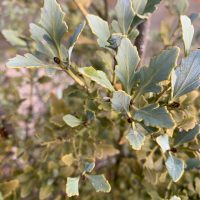Summer Specials at the Washington Park Arboretum

1) Fuchsia magellanica Hardy Fuchsia
The stunning display of pink flowers currently on Fuchsia magellanica are enjoyed by hummingbirds and humans.
This widely cultivated small ornamental shrub is native to Argentina and Chile.
You can find this and other Fuchsia sp. blooming in the Pacific Connections Garden.
2) Lagerstroemia ‘Natchez’ Natchez Crape Myrtle
An attractive small deciduous tree with slender, mottled stems.
Read moreAustralian Inspiration at the Washington Park Arboretum

1) Ozothamnus rosmarinifolius ‘Silver Jubilee’
The silvery foliage serves as a lovely backdrop for the dense clusters of white flowers in spring.
This shrub can grow to about four feet tall and wide and is a member of the Asteraceae family.
You can find Ozothamnus rosmarinifolius ‘Silver Jubilee’ blooming in the Australian portion of the Pacific Connections Garden.
2) Callistemon pityoides (Mt.
Selected Cuttings from the Center for Urban Horticulture

1) Buddleja longiflora
This rare evergreen butterfly bush is native to the Serra do Caparao mountains in Brazil.
What makes this Buddleja species unique from other species and cultivars is its stunning, long tubular orange flowers that are paired in three-to-five flowered cymes.
Its flowers, plus striking white tomentose leaves and small stature (four feet), make this a worthy plant to introduce into the nursery trade.
Selected Cuttings from the Home of UW Botanic Gardens Horticulture Manager, David Zuckerman

1) Buddleja globosa Orange Ball Buddleja
This Chilean large and lanky quasi-evergreen shrub comes true to name when in flower.
It is now festooned with 8-10 fragrant orange ball-shaped flowers arranged in terminal panicles.
Hummingbirds are fun to watch while hovering and feeding over each “ball” for several seconds.
You can view several blooming now in our Pacific Connections Chilean Gateway Garden.
Selected Cuttings from the Home of Annie Bilotta, Horticulturist at the Center for Urban Horticulture

Pacific Northwest Natives
1) Berberis aquifolium, formerly known as Mahonia aquifolium Tall Oregon Grape
Native to the Pacific Northwest from British Columbia to northern California.
Its yellow flowers in April smell like honey and attract hummingbirds and insect pollinators.
Blue-black berries are edible and are used to make jam and juice. Pacific Northwest aboriginal peoples used the bark and roots to make a yellow dye.
Preserving Australian Flora in the Washington Park Arboretum

The Pacific Connections Garden (PCG), found at the southern end of the Arboretum, is a place that spurs the floristic imagination. Visitors traverse hemispheres and continents while moseying through gardens that showcase plant communities from specific regions in New Zealand, China, Cascadia, Chile, and Australia. In a short walk it’s possible to pass through our version of the New Zealand high country, continue on to the Cascadia garden, featuring plants native to the Siskiyou mountains, and finish with our representation of the wine palm and monkey puzzle laden temperate rainforests of Southern Chile.
Read moreSelected Cuttings from the Home of Joanna Long, Pacific Connections Horticulturist

Native Ground Covers in Bloom
1) Trillium ovatum Pacific Trillium
The three white petals of Trillium are always a sign of spring. As they age, the petals turn pink.
These native wildflowers are common under-story plants in our woods.
The seeds of Trillium contain a substance attractive to ants who act as seed dispersers.
Scattered populations of Trillium bloom throughout the native areas of the Arboretum.
Selected Cuttings from the Home of Roy Farrow, WA Park Arboretum Grounds Supervisor

1) Acer palmatum ‘Katsura’ Japanese Maple
Japanese maples have been cultivated in Japan for over 300 years. While they are most known for their stunning fall colors, I personally enjoy them as much in the spring for their new leaf color.
‘Katsura’ is a cultivar which appears to have bright orange new leaves, but on closer inspection, the leaves are bright yellow with a red margin.
Spring Transition at the Washington Park Arboretum

1) Cornus mas Cornelian Cherry
This yellow flowering tree that blooms in late winter to early spring, is native to southern Europe and southwestern Asia.
The common name refers to the fruit that matures in late summer. The fruit has many cultural uses including jams, medicine, beverages, tools, and spears.
There is a grove of this Cornus at the Center for Urban Horticulture along NE 41st Street.
Arriba for Azaras!

Azara is a genus of plants native to the temperate and subtropical regions of South America. The Chilean name for these plants is Corcolén. The genus contains only ten species, four of which you can find growing here at the Washington Park Arboretum! All species of Azara are evergreen shrubs to small trees. Although some species of Azara are considered to be borderline hardy in our Pacific Northwest climate, we have had success growing them at the Arboretum.
Read more